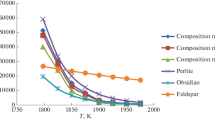Abstract
A new theory which allows the bulk modulus of polycomponent oxide glasses to be estimated to a precision of about ±7% or better, is described. It is suggested that the bulk modulus is approximately proportional to the product of the reduced Madelung constant, the mean valence charge product weighted by the relative ionicities of the various bonds, the fourth power of the reciprocal molar volume per ion pair, and a factor less than 1 which increases with the mean stiffness of bonds. The relationship can be simplified by assuming that the ionicity and stiffness factors cancel and the important result is that the product expressing the theoretical bulk modulus can be evaluated solely from a knowledge of the coordination numbers in the crystalline forms of the component oxides, and the glass composition and density. A good correlation between this simplified product and the experimental modulus of a large range of phosphate and silicate glasses is obtained, providing that the mean valence charge product does not exceed the value obtaining in the parent glass.
Similar content being viewed by others
References
K. L. Lowenstein,Phys. Chem. Glasses 2 (1961) 69.
A. Makishima andJ. D. Mackenzie,J. Non-Cryst. Solids 12 (1973) 35.
Idem, ibid. 17 (1975) 147.
C. Zwikker, “Physical properties of Solid Materials” (Interscience, New York, 1954) p. 91.
O. L. Anderson, in “Physical Acoustics IIIB” edited by W. P. Mason (Academic, New York, 1965) pp. 43, 64–75.
O. L. Anderson andJ. E. Nafe,J. Geophys. Res. 70 (1965) 3951.
O. L. Anderson andN. Soga,ibid. 72 (1967) 5754.
D. L. Anderson,ibid. 74 (1969) 3857.
J. J. Gilman, “Micromechanics of flow in Solids” (McGraw-Hill, New York, 1969) pp. 29–42.
O. L. Anderson andD. L. Anderson,J. Geophys. Res. 75 (1971) 3494.
O. L. Anderson, in “The Nature of the Solid Earth” edited by Eugene Robertson (McGraw-Hill, New York, 1972) Ch. 21, pp. 576–613.
G. P. Davies,Geophys. J. Astronom. Soc. G.B. 44 (1976) 625.
N. Soga andO. L. Anderson, 7th International Congress on Glass, Brussels (1965) (Inst. Nat. du Verre, Charleroi, Belgium, 1966), paper 37.
O. L. Anderson,J. Geophys. Res. 71 (1966) 4963.
D. L. Anderson, in “The Earth's Mantle” edited by K. Runcorn (Pergamon, Oxford, 1966) Ch. 3.
N. Soga, R. Ota andM. Kunugi, in “Mechanical Behaviour of Materials” Vol. 4, edited by S. Tiari and M. Kunugi (Society of Materials Science, Kyoto, 1972) pp. 336–73.
N. Soga, M. Kunugi andR. Ota,J. Phys. Chem. Solids 34 (1973) 2143.
F. Birch,J. Geophys. Res. 65 (1960) 1083.
B. Bridge andA. A. Higazy,Phys. Chem. Glasses 27 (1986) 1.
D. H. Templeton,J. Chem. Phys. 21 (1953) 2097.
Idem, ibid. 23 (1955) 1629.
D. Quane,J. Chem. Ed. 47 (1970) 397.
Q. C. Johnson andD. H. Templeton,J. Chem. Phys. 34 (1961) 2004.
M. P. Tosi,Solid State Phys. 16 (1964) 1.
A. A. Higazy andB. Bridge,J. Non-Cryst. Solids 72 (1985) 81.
B. Bridge andN. D. Patel,J. Mater. Sci. 21 (1986) 1187.
B. Bridge, N. D. Patel andD. N. Waters,Phys, Status Solidi (a) 77 (1983) 665.
B. Bridge,Phys. Chem. Glasses 29 (1988) 37.
V. V. Tarasov, “New Problems in the Physics of Glass” (Israel Programme for Scientific Translations, Jerusalem, 1963) Ch. 5.
R. R. Shaw andD. R. Uhlmann,J. Non-Cryst. Solids (1971) 237.
A. V. Gladkov,Sov. Phys. Techn. Phys. 2 (1967) 612.
A. V. Gladkov andV. V. Tarasov,Structure of Glass 2 (1960) 227.
M. B. Field,J. Appl. Phys. 40 (1969) 2628.
J. M. Farley andG. A. Saunders,Phys. Status Solidi (a) 28 (1975) 199.
B. Bridge andN. Hashim, to be published.
B. Bridge,J. Mater. Sci. Lett. 6 (1987) 736.
D. N. Wells, “Structural Inorganic Chemistry” 4th Edn (Clarendon, Oxford, 1975).
Author information
Authors and Affiliations
Rights and permissions
About this article
Cite this article
Bridge, B. A model for estimating the bulk modulus of polycomponent inorganic oxide glasses. J Mater Sci 24, 804–810 (1989). https://doi.org/10.1007/BF01148760
Received:
Accepted:
Issue Date:
DOI: https://doi.org/10.1007/BF01148760




